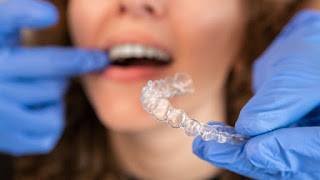Without braces, how can you fill a gap in your teeth?
Orthodontic therapy, often known as a ceramic brace, is frequently recommended for closing tiny gaps or spacing between teeth, especially if the teeth are mostly undamaged and of the proper size and proportion. Modern orthodontic treatment may be personalized to your desires, with alternatives such as discrete or even invisible treatment. The 'hidden' brace method is shown by lingual braces and Invisalign.
However, if appropriate, some cases of tooth spacing and gaps can be treated
with alternative therapies.
Continue reading to learn about all of your alternatives.
TEETH FILLING OPTIONS WITHOUT THE USE OF A BRACE
Braces aren't required to close all gaps in the teeth. Whether or not braces
are required is totally dependent on the cause of the gap. The dentist will
need to determine what occurred to the teeth to generate the gap, and then
choose which remedy is the most effective.
These are the braces choices, each of which is dependent on the state of the
teeth.
DENTAL BRIDGES OR IMPLANTS
Dental
implants or fixed bridgework may be the best option if the gap is caused by
a missing or recently lost tooth or teeth.
BONDING COMPOSITE
To fix small gaps between teeth, tooth-colored composite bonding can be used to
bridge the crevices.
When done correctly in the right scenario, this is a reasonably
straightforward, long-lasting, and non-invasive technique that yields
outstanding outcomes.
DENTAL VENEERS are a type of dental veneer that is used to cover the
Dental veneers are thin shells that are put over teeth to enhance their form
and look. If the teeth are smaller than normal, worn down, abraded, or
destroyed by acid erosion, this might be an indication (from diet or factors
such as acid reflux). Veneers may also be recommended if the tooth forms and
proportions are off, or if the teeth are otherwise deformed.
DENTAL CROWNS are a type of dental crown.
Dental crowns
should only be used to repair gaps in teeth if the teeth have been injured in
some manner, such as by massive fillings, decay, or fracture, or in situations
of severe wear and erosion. They are used to restore the form, strength, and
appearance of a prepared tooth.
ARE BRACES BETTER FOR FILLING GAPS?
The health of the teeth and the reason for the gap will determine whether or
not braces are needed. If the teeth are in decent condition and size but have a
gap or gaps, braces are usually recommended. The gap(s) is most likely caused
by the arch length, which would require orthodontic treatment to close.When a
tooth or teeth is missing, braces may be the best option for closing
my gap without braces, especially if the teeth are crowded or crooked and
require orthodontic treatment anyway. For young patients (adolescents) with
congenitally lacking teeth, braces are frequently the best option.


Comments
Post a Comment